|
Posted in category "Scandals"
After the Stonewall raid, Ed Murphy went to work at Tele-Star, another gay bar. The Tele-Star was raided soon after by police. Murphy told friends that he refused to let police into the bar, so they had beaten him up very badly. He was covered in cuts and welts, had bandages all over his face, his arm was fractured, and he was barely able to walk. The beating may have been at the instigation of Deputy Inspector Seymour Pine, who must have been furious about not netting him at Stonewall. Some officers may still have been angry that Murphy impersonated a police officer during the “Chickens and the Bulls” extortion schemes, and it was payback time. Murphy was also raped by a black inmate during his jail stay. Murphy said the police heard he “liked niggers” and that he hung out with and protected black teenagers and transvestites. After Murphy was released from jail, he stopped informing for the NYPD.
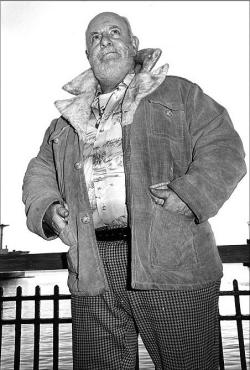 Ed Murphy, 1978 In 1978, Ed Murphy “came out” as a gay man and stopped informing on the Mob to the FBI. He was 52. Murphy claimed that he wanted to quit both his careers as a criminal freelancer and as an informer, and work for gay liberation. He wanted to become a “good guy.” Ed continued working at gay bars, which were mostly mob run, so his association with members of the Genovese and Gambino families continued until his death in 1989. I don’t see how the Mafia would let an informer walk around and live; Ed would have ended up in a swamp, empty field, or vacant lot. Having Ed inform to the FBI was useful—he could have been fed information about certain people and his informing allowed the Mafia to keep tabs on FBI activity and plans. Ed saying that he no longer worked for the FBI may have been true or a ruse. Murphy did testify in 1979 that he had been an undercover agent specializing in gay bars and corruption for the New York State Select Committee on Crime.
In a May 8, 1978, Village Voice article by Arthur Bell, “Skull Murphy – The Gay Double Agent,” Murphy disclosed that he decided to come clean because certain mobsters became aware he was an informer. “Everything I know is on file at law enforcement agencies for certain people doing investigations,” he told Bell. Look, I’m getting old. I’m getting out of this business, baby. I’m doing it for one reason. I want to see their asses kicked.”
I find it impossible to believe that Ed Murphy ratted on the mob for years and lived to walk away after testifying. He was low level and sullied enough that a gunman could put a bullet in his head and get away with only a pretense of an investigation. Who would mourn? Not the influential gay men and officials that he served and compromised. Not the NYPD. Instead, Ed continued to live and work in New York at mob-affiliated gay bars and clubs. He solicited cash donations from businesses, many of them mob-owned, to help fund the Christopher Street Festival and annual gay pride day parade. More likely, much of the information that Murphy provided had to do with corruption and sexual antics by politicians, government officials, men in law enforcement, and others that would be embarrassing to be publicly aired. A friend reacted to Murphy’s pronouncements: “Even the criminal element has a code of ethics. If the Skull’s planning a trip to heaven, he won’t get there by hurting people.”
In 1972, Murphy founded the Christopher Street Festival Committee. It was started to help the local merchants profit from Gay Pride Day and, to give people who felt uncomfortable marching a place to meet and mingle with other gay people. When I was marching in the 1980s and early 1990s, there were thousands more people at the festival than at the parade. The parade included primarily middle class and affluent white people. There were a lot of banners of community service or activist groups, including religious groups and some church and synagogue groups. The original march in 1970 started in the Village and ended up in Central Park.
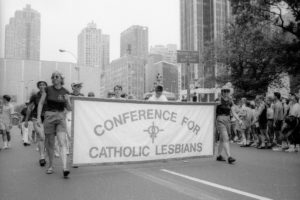 CCL at NYC Gay Pride March, 1988 By 1974, Murphy had persuaded march organizers to start the parade uptown and finish at Christopher Street. His main motive was probably money, since the bars, clubs, booth merchants, and area businesses would rake in bags of cash from marchers and revelers. But while making money was the biggest driver, I also feel that Ed wanted to include the thousands of people who didn’t march out of fear of family rejection, job loss, or just fear. Many of them were black, Latino, and blue-collar whites. Murphy almost single-handedly ran and controlled the festival. Most participants were happy with the crowd and the freedom to “be,” if only for an afternoon or night. “People often wondered where they money went,” said Candida Scott Piel, a long-time AIDS and gay rights activist who helped to organize the Pride parade and rally in the ‘80s. “But if your group ever needed help, or you were just someone in need, Ed was always there to lend a hand or find someone who could.”
Every year Murphy would come by the Conference for Catholic Lesbians booth on Christopher Street to say hello, see how we were doing, and make sure that no one from the commercial vendor booths was bothering us. Eventually he would end up at one of the nearby bars, like Two Potato, holding court with a group of young guys. Prior to the Festival, Ed took part in the Pride parade. He would ride with a group of young men in a Cadillac convertible. A picture from the 1984 parade shows him all dressed up in a blazer wearing a blue sash with the words, “The Original Stonewaller.” His hands are raised as if in a benediction to the crowd.
 Ed Murphy, NYC Gay Pride March, 1984 Ed Murphy’s life after Stonewall had taken a surprising turn after his previous incarnations as a juvenile delinquent, WWII soldier, armed robber, gay bar bouncer, pro wrestler, pimp, house detective, fairy-shaker, and informant: he became a community activist. During the 1970s and ‘80s, Ed Murphy was known for charity work with homeless street youths, drag queens, prostitutes, people suffering with AIDS and the mentally handicapped. He was named New York State’s volunteer of the year in 1977 for his work with people with developmental disabilities.
Ed Murphy would round up his friends and treat people in residential facilities to parties for Thanksgiving, Christmas, Easter, and summer picnics. He would dress up as Santa Claus for Christmas, and in his all-purpose tramp-clown outfit for the other occasions. “He’s a marvelous man,” said the coordinator of volunteer services for one of the homes. “Whenever we need something in a pinch, Ed Murphy is there. It doesn’t matter if it’s shoelaces or an excursion.” Murphy did whatever needed to be done to make Christmas special. “One year we wanted to have a house for Santa Claus to sit in, but we didn’t have no money,” he recalled. “So a couple of the guys go down to this yard on 10th Avenue and rob some lumber. After the party, they put it back, but the owner comes into the bar and complains. I asked him what he’s yelling about, its only got a couple of nail holes in it. The next year, he donates the lumber for free.”
From his job as a doorman/bouncer, Ed collected a group of fellow bar workers, patrons and ex-cons who help him with the parties. “We’re here with Eddie,” said a man who pushed a cart full of presents for the residents told a reporter. “The guy’s a nice guy, and, like, he loves people. I been in a few institutions myself, so I know what that means.” Murphy had an informal group of 50 bars, most of them gay bars, to help provide food, drinks, and gifts for the parties. “We don’t accept money,” Murphy said. “We’ll ask one bar for hamburgers, another for soda, and so forth.” He got bakeries to donate to AIDS hospices and old age homes. He even got Detective Jim McDonnell from his “Chickens and Bulls” days to do some volunteer work when he retired. Murphy surprised McDonnell with a plaque at an awards dinner.
After Stonewall, Ed Murphy appears to have made a complete transition from a thug who threatened gay men for money; to a burly, bewhiskered Santa Claus who distributed gifts and treats to bring joy to people who would have had neither. What happened to Ed Murphy? Why did people never mention his role in the “Chickens and the Bulls” or even his alleged blackmail role for the mob at Stonewall? It was the ultimate irony to see the man the cops were after during the Stonewall raid for financial crimes at the head of the Gay Pride parade proudly wearing the sash proclaiming, “The Original Stonewaller.”
Once the New York Police Department learned that the stolen bearer bonds were tied to the Stonewall Inn, they set out to shut down the club and arrest Ed Murphy. In the early hours of June 28, 1969, a few hours after Judy Garland’s funeral, the police raided the club. The force was led by Deputy Inspector Seymour Pine, and carried out without the knowledge of the local precinct which was suspected of being on the take. Even though they were after Murphy, the police officers were brutal to the patrons.
 Stonewall Raid, 1969 They started the operation by sending in two policewomen “posing” as lesbians and two plainclothesmen. The undercover women were from Chinatown’s Fifth Precinct. They were chosen because of their sizes (one large, one petite) to be a butch-femme couple. Pine became worried when the two policewomen didn’t return. “They didn’t come out of the bar,” Pine said. “Time passed. It seemed unnatural. We didn’t realize they were having a good time. It got to the point where we thought they were in trouble or had forgotten what they were supposed to do.” Ed Murphy recalled, “the two cops were drunk…Even the policewoman was half-crocked. She was a Polynesian broad. And she’s been coming there as a dyke.”
In an interview with the SAGE (Senior Action in a Gay Environment) History Project, Ed Murphy recounted his own memories of the Stonewall Raid. An excerpt was published in the June 1989 SAGE newsletter. “I was one of the two men employed as bouncers at Stonewall on the night of the celebrated raid,” Murphy said. “I was told that the monthly payoff to the cops from Stonewall was $1200 plus frequent cases of booze. The Inspector got his $1200 payoff the very night of the raid, using his chauffer as bagman as usual. Every gay bar paid.”
“Stonewall was an after-hours premises, not a bar. It had two big oak doors rather like doors to a monastery. Inside that were steel doors. Inside the premises there was a Wishing Well in the middle of the dance floor and upstairs the “mob” retained a room. A Polynesian policewoman was already inside when the doors were slapped shut against the raid.”
“Maggie (Jiggs) is said to have thrown the first beer can at the police. Marcia picked up dog shit and threw it in a cop’s face. Maggie got out with the money…She put the money under her apron, told the cops, “I just sell cigarettes here” and got away with the money so the cops didn’t get any. Meanwhile, Frankie, the other bouncer, and I were handcuffed by the cops. In the melee we jumped into a cab. Turned out to be a gay cabbie who sped us off to Keller’s Bar. There the S&M crowd had keys that fit the handcuffs.”
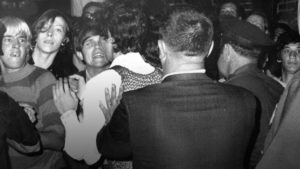 Stonewall Riot, 1969 The SAGE newsletter editor noted that Ed Murphy had recently died. He described him as: “a long-standing, compassionate and vociferous member of the gay and lesbian community. His leadership and strength were constant and are sorely missed.”
If the main objective of the Stonewall raid was to arrest Ed Murphy and haul in a load of incriminating evidence, it was a total failure. There was no mention of whether the “upstairs room” was searched. Ed slipped away even though he was handcuffed. It makes you wonder if the police were totally incompetent or if Murphy was tipped off to the raid by a source or even one of the police who infiltrated Stonewall before the raid. Fury at both the police and the Mafia fueled the crowds. One of the goals shared by the Gay Activists Alliance and the Gay Liberation Front, two groups that came out of the Stonewall protests, was to get organized crime out of gay bars. That didn’t happen immediately. Bars, clubs, pornography, and other gay-related businesses were far too lucrative for organized crime to give up easily.
The Stonewall Inn in Greenwich Village, New York City started life as Bonnie’s Stone Wall, named after the autobiography of Ruth Fuller Field (1864-1935), The Stone Wall. Although it was written under the pen name of “Mary Casal,” the book was extraordinarily frank in its descriptions of lesbian love and sexual attraction. In 1967, the building was reopened as a gay bar by “Fat” Tony Lauria, the son of a Mafioso and several partners. One of them was Matty “the Horse” Ianniello, the acting boss of the Genovese family. Ianniello was widely acknowledged as the Genovese capo who controlled most of New York’s gay bars and clubs. The New York State Liquor Authority refused liquor licenses to any bar that catered to open homosexuals. This created an opening for organized crime to run bars without licenses and pay off police.
 Matty “The Horse” Ianniello  The Stonewall, 1960s The Stonewall Inn was a dump. The bar had no running water; glasses were washed in a bucket. Urine soaked the toilet floor. There were no fire exits. But The Stonewall Inn had a special draw: it was the only gay bar that permitted dancing. From an upper room and back entrance, the Stonewall also offered drugs and male prostitutes. One of the bartenders, a chubby blond drag queen named Maggie Jiggs, presided over the main bar, and sold drugs in addition to Stonewall’s watered drinks. Ed Murphy was the burly doorman-bouncer. Murphy had been a ubiquitous presence in gay bars since 1946. He was still closeted in 1969, but he had sex with young men and pimped them out for tips. Murphy was said to have worked with Gambino Family associate Mike Umbers, a pornographer, to pimp teenage boys to wealthy men. Umbers reportedly had a minor role in the “Dog Day Afternoon” botched bank robbery. Umbers pressured John Wojtowicz to pay back his loan to the mob by robbing a bank. Wojtowicz borrowed the money to pay for his wedding and sex change operation for his wife, Liz Eden. Wojtowicz claimed that the idea to rob a bank came from a Chase Manhattan executive that he met in a Greenwich Village gay bar.
Did Ed Murphy continue the blackmail schemes at the Stonewall Inn that he utilized earlier during “The Chickens and the Bulls” scandal? Was he working with members of organized crime families to blackmail gay men? Was he protected by the FBI as an informer? All the evidence seems to point that way.
In his 2004 book, “Stonewall: The Riots that Sparked the Gay Revolution,” historian David Carter debunked the myth that the New York Police Department’s raid on Stonewall was intended solely to harass gay patrons. Carter studied the 1969 police files on the raid and interviewed the man who planned and led it, Deputy Inspector Seymour Pine. Pine recalled that months earlier he was called into the office of his commanding officer to discuss stolen bonds. Interpol had noticed that an unusual amount of negotiable bonds were surfacing in Europe and had requested that the NYPD investigate. Were the bonds legal or counterfeit? Who was behind it?
 NYPD Deputy Inspector Seymour Pine The NYPD investigation found evidence that the Mafia was involved along with some Wall Street employees who frequented the Stonewall Inn. Carter suggested that Murphy supplied members of the mob with names and personal information that could be used for blackmail. The police concluded that bonds had been stolen by a closeted Wall Street executive at the bidding of gangsters operating out of the Stonewall Inn. Lucian K. Truscott IV, the writer who covered the Stonewall Riots for the Village Voice, wrote an article for the New York Times in 2009, “The Real Mob at Stonewall.” Truscott related that “Deputy Inspector Pine had two stated reasons for the raid: the Stonewall was selling liquor without a license, which it was, and it was being used by a Mafia blackmail ring that was setting up gay patrons who worked on Wall Street, which also seems likely.”
The victims were set up for Murphy by the good-looking bartenders and waiters at Stonewall. The waiters would get friendly with customers and ferret out personal details. If the customer was connected or had a big job on Wall Street, the man was a good mark. “It’s really so insidious,” said one Stonewall regular, “when you’re talking to somebody that you find nice—he’s being nice, pleasant finally. Eventually you tell him where you work, and then all of a sudden this happens. It’s just so awful.”
Some victims had their wallets stolen by prostitutes. The blackmailers researched which men might be vulnerable to extortion. The Stonewall Inn also maintained a membership list. Anyone who wanted to be admitted needed to sign a book. Wise patrons used fake names, but lots of others used their real names. Blackmailers used these membership lists, plus the information pumped by waiters, to identify well-placed homosexuals in the financial industry. Closeted Wall Street employees were probably threatened by Murphy. I can see him promising to protect their anonymity, in exchange for financial instruments that the mob wanted.
The Mattachine Society of New York, the city’s first gay rights organization, had experience with Ed Murphy during “The Chickens and Bulls” extortion scandals a few years earlier. They alerted their members and others who purchased their gay bars guide that Ed Murphy was active at The Stonewall and to be wary of him. “MSNY has also been informed that Murphy has an interest in the Stone Wall, a club on Christopher Street, and several other gay clubs in New York…We caution our readers NEVER to use your real name when cruising, NEVER to give your address to a questionable bar or club, and remember, that trick or hustler you’ve just picked up may be “working” for management! We urge you, if you’ve been intimidated or blackmailed in the past, to report it to the D.A.’s office, or to M.S.NY.”
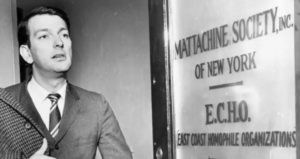 Dick Leitsch, Mattachine Society In their March 1968 newsletter, the Mattachine Society described their role in aiding the New York City District Attorney’s office with information that led to the arrest of several blackmailers. They also made a point to identify one of them—“Edward F. P Murphy, an ex-convict who is alleged to have been the head of a national ring which recently was active in extorting money from homosexuals…has served prison terms for larceny and for carrying deadly weapons, and was arrested for impersonating an officer, and for extortion…”
Ed Murphy was never charged in the Stonewall shakedowns or stolen bonds. Neither the men who stole the bearer bonds nor the men who sold them were ever charged or punished. However, the incident led to a crackdown in the financial services industry, and many gay men lost their jobs or careers and were ruined. The head of the Mattachine Society, Dick Leitsch, gave this statement before the New York State Assembly at its “Hearings on Homosexuality” on January 7, 1971:
“Last year, following a wave of thefts from Wall Street brokerage houses, the State issued an order that all employees in the financial industry be fingerprinted. Because of this, many old and trusted employees had to be let go, because bonding companies will not insure known homosexuals and the fingerprint checks turned up evidence of old arrests. Banking and many other fields requiring bonds are off-limits to homosexuals because of this policy of bonding companies.”
This act capped a decade of exploitation and degradation of hundreds, if not thousands, of gay men and youths by Ed Murphy. He was protected by the FBI, the NYPD, the Mob, the New York State Select Committee on Crime, and his own fists, friends, and personality. He got away with it. In a tremendous irony, the Stonewall raid to arrest him for blackmail instead morphed Ed Murphy into a gay liberation legend.
Ed Murphy told me: “J. Edgar Hoover is one of my sisters.”
In 1983, I was shocked to hear Ed insinuate that the late FBI director was gay and liked to dress in women’s clothes. Even among very gossipy gay men, I never heard a breath of rumor that the late FBI director liked guys and was also a transvestite. Similarly, in the 1980s at Dignity/NY, I learned that the ruthless society lawyer, Roy Cohn, had contracted AIDS, not cancer of the liver as he claimed. Ed may have known about Hoover from firsthand stories he heard, and likely had pictures to prove it. I’m not clear if Ed Murphy’s claims are from the time of the “Chickens and the Bulls” blackmail period, or, whether the Mafia had compromising photos of Hoover and his associate director and companion, Clyde Tollson, from years before.
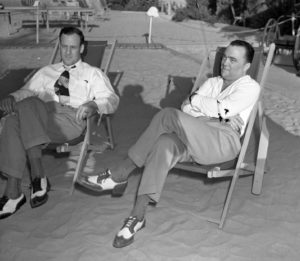 Clyde Tollson and J. Edgar Hoover on vacation In his explosive 1993 book, “Official and Confidential: The Secret Life of J. Edgar Hoover,” author Anthony Summers claimed Hoover denied the existence of the Mafia and never pursued them because the Mafia had blackmail material on him. One of the photos was said to show Hoover blowing Clyde Tollson. The knowledge of Hoover’s homosexual activities may have kept gangsters like Meyer Lansky and Frank Costello safe from FBI scrutiny.
Author David Carter wrote in his 2004 book, “Stonewall: The Riots That Sparked the Gay Revolution,” that when FBI agents joined the “Chickens and the Bulls” case, they found a photograph of J. Edgar Hoover “posing amiably” with one of the ringleaders and discovered information that Clyde Tollson was being blackmailed by the extortion ring. Both the photograph and documents disappeared after the FBI joined the investigation. David Carter thought Ed Murphy was the man posing with Hoover. Journalist and author Burton Hersh said that it was Sherman Kaminsky. It may be that Ed Murphy’s decades of work in Mafia-run gay bars, and his involvement in male prostitution and blackmail gave him access to knowledge and photos, which not only kept him safe from the Feds, but out of jail in the “Chickens and the Bulls” case.
Elwood Hammock, one of the chief extorters in the “Chickens and the Bulls” case also said that J. Edgar Hoover was homosexual as detailed in a memo dated May 19, 1966, from Special Agent in Charge (SAC) in Charlotte, N.C. to Director, FBI. The memo describes a taped telephone interview with an unnamed woman the evening of May 18, 1966. It was conducted by FBI agent Charles S. Miller of Durham, N.C.
“(BLANK) stated that on or about 4-10-66 (BLANK) ELWOOD HAMMOCK (BLANK) New York City. She recalled that ELWOOD was intoxicated at the time, and he was discussing various personalities in whom he and his confederates were interested. During the course of this conversation, he stated to her that J. EDGAR HOOVER was a homosexual. He stated also that he, ELWOOD HAMMOCK, and (BLANK) who she later learned was (BLANK) allegedly had telescopic movies or photos of a blond, blue-eyed young man who resided in either Georgetown or Bethesda, Maryland. It was not clear to (BLANK), but she gathered that this young man was guarded by two Doberman pinscher dogs, and she gathered by inference that this young man was an alleged friend of MR. HOOVER. She stated she was shocked when ELWOOD made such a fantastic allegation, and she informed him that it was utterly impossible and untrue. She stated that (BLANK) was an inveterate liar, and she placed no substance in his statement. She stated she admired the Director greatly, recognized what he had done for the country, and as she thought about the matter more, she decided to repeat ELWOOD’S conversation to a Detective (BLANK) of the New York District Attorney’s staff with whom she had been working.”
The person who had the most damaging information about J. Edgar Hoover was Susan Kaufman Rosenstiel, the 4th wife of liquor magnate Lewis S. Rosenstiel, chairman of Schenley Industries, Inc. Rosenstiel, a bisexual, was a former bootlegger who was a close associate of mobsters Meyer Lansky and Frank Costello. He was good friends with power broker attorney, Roy Cohn, and J. Edgar Hoover. He endowed the J. Edgar Hoover Foundation with $1 million in 1965. Lewis Rosenstiel’s lifelong involvement with mobsters came to light only in 1970, when the New York State Legislative Committee on Crime determined that he was part of a consortium to smuggle liquor during Prohibition.
Lewis and Susan Rosenstiel had an ugly, contentious divorce before Lewis Rosenstiel moved on to Wife #5. Rosenstiel spent almost half a million dollars trying to concoct evidence to use against his wife in divorce proceedings. He may have turned to his friend, J. Edgar Hoover, for help. At least, this is what Susan Kaufman thought, believing that the FBI director helped stack the cards against her in divorce court. In retaliation, she told anyone who would listen that Hoover was a cross-dresser and homosexual.
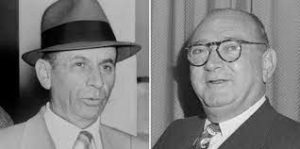 Meyer Lansky & Lewis Rosenstiel During their divorce, Rosenstiel’s 4th wife, Susan Kaufman, alleged that Rosenstiel hosted orgies at the Plaza hotel where he supplied “boy prostitutes” for certain guests. Kaufman would later make the same claims under oath for the New York State Joint Legislative Committee on Crime in the early 1970s. Most of Kaufman’s testimony to the Committee was behind closed doors and remains sealed. Her claims are shocking, but both the Crime Committee Chairman, John Hughes, and his Chief Counsel, Edward McLaughlin, found them credible. McLaughlin remembered her as an excellent witness: “I thought she was absolutely truthful. The woman’s power of recall was phenomenal. Everything she said was checked and double-checked, and everything that was checkable turned out to be true.”
 Roy Cohn on vacation Larry Summer’s book, Official and Confidential: The Secret Life of J. Edgar Hoover,” describes one night in 1958 where Susa n Rosenstiel witnessed a sex scene with her husband, Roy Cohn, J. Edgar Hoover and two teenage boys in a suite at the Plaza Hotel in New York. Hoover was in drag, “wearing a fluffy black dress…lace stockings and high heels, and a black curly wig. He had makeup on, and false eyelashes. Roy introduced him as “Mary” …It was obvious he wasn’t a woman; you could see where he shaved.” They had some drinks, and the teenage prostitutes arrived. They went into the bedroom and “Mary” undressed, taking off his dress and pants and leaving on a garter belt. He lay on the bed, “and the boys work on him with their hands. One of them wore rubber gloves…Then Rosenstiel got into the act with the boys. I thought, “You disgusting old man.” Hoover and Cohn were watching, enjoying it.”
If what she described happened, it would be easy to imagine that Meyer Lansky and others in organized crime had blackmail photos of Hoover in a dress or getting serviced. Susan Rosenstiel quoted her husband as saying, “because of Lansky and those people, we can always get Hoover to help us.” Hoover was a blackmailer himself. “He was the biggest fuckin’ extortionist in the country,”
Ed Murphy told Arthur Bell in a 1978 interview. “He had presidents by the balls. He had a record on everybody and his brother.”Not everybody believed Susan Kaufman’s stories. Robert M. Morgenthau, the U.S. Attorney in New York, found her claims baseless. So did famous attorney William Hundley, at that time working in the U.S. Justice Department. “Susie Rosenstiel had a total axe to grind,” Hundley said. “Somebody who worked for me talked to her. It was made up out of whole cloth. She hated Hoover for some alleged wrong he had done. Plus the story was beyond belief.”
The story does sound fantastical. How could the head of the FBI–and a notorious blackmailer himself–get himself into a position where he was held hostage? Perhaps it was a trade-off. Hoover had his secrets protected and access to male prostitutes. In return, organized crime didn’t need to worry about the FBI nosing too deeply into their operations.
Coming Tomorrow: Chapter 5: Stonewall Shakedowns
The blackmail scheme of “The Chickens and the Bulls” as the New York City Police Department called it, or “Operation Homex” to the FBI, is now unknown or forgotten by most lesbian and gay people and activists. The name refers to an extortion ring of cops and criminals that preyed on prominent, closeted gay men in the 1960s. Corrupt police officials and police impersonators known as “Bulls” used young male prostitutes called “Chickens” to blackmail wealthy, important, or closeted pillars of the establishment across the country. The ring victimized thousands of men, including politicians and government officials, military officers, film, TV and entertainment celebrities and producers, prep school and university professors, headmasters, and trustees, surgeons, scientists, business executives, and Catholic priests. Most of the “chickens” were teenage runaways from homophobic or abusive family backgrounds. They survived by turning tricks in the back of trucks parked on waterfront piers, seedy hotels, or getting pimped out to strangers.
This is how the scam worked: a man would travel to a large city, like New York or Chicago, where he would procure the services of a male prostitute. The prostitute would be solicited at a gay bar, in the bar of a hotel, or in the hotel’s men’s room. Sometimes the Concierge of the hotel was involved. Once the blackmail victim and his prostitute were alone in a hotel room, one of two things would happen; the prostitute would steal the man’s wallet and run out of the hotel, or the “Hotel Detective” would burst into the room and demand cash for not arresting the visiting victim. The stolen wallet would be turned over to the ringleaders, who with their corrupt law enforcement associates, would compile information on the victim. If the “John” was rich, famous or from a prominent family, two members of “law enforcement” would travel to the man’s home or place of business and threaten him with public exposure – even arrest – unless they were given cash to make the case disappear. The men paid rather than have their homosexuality disclosed. One such encounter, heavily redacted, was described in an FBI memo:
“(BLANK) is a guitar player with (BLANK) and while in New York City in 1965 picked up and committed oral copulation on (BLANK) at the Hilton Hotel, 34th Street. Upon (BLANK) return to California, he was approached by an individual named (BLANK)…who posing as a New York City police officers, extorted an unknown sum of money from him. The extortion again was a result of threatened public exposure and/or incarceration for a New York City homosexual act.”
As the NYPD and the FBI pursued their investigations in 1965 and 1966, they found that the blackmail ring operated in large cities around the country and had a fluid cast of about two dozen chickens and bulls. One of them was Edward Murphy, who was the house detective for the Hilton Hotel on 34th Street in New York. “DETECTIVE AT HOTEL IS HELD IN EXTORTION” the August 5, 1965, New York Times headline blared.
“A 39-year-old house detective at the New York Hilton was arrested early yesterday as the leader of a gang that had extorted a total of $100,000 from “rich playboys and executives…The house detective, Edward Murphy, was held in $7,500 bail for a hearing August 13. He was charged with extortion and impersonating an officer.”
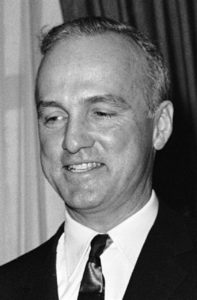 Rep. Peter Frelinghuysen, 1960s Among the men that Ed Murphy identified as victims of the blackmailers were Congressman Peter Frelinghuysen (R-NJ) and Admiral William Church, cousin of the powerful senator Frank Church (D-ID), and head of the New York Naval Yards in Brooklyn. An FBI memo described the night Rep. Frelinghuysen picked up a chicken:
“(BLANK) stated the Congressman was very scared and he told (BLANK) that he was a doctor and that his wife and kids were out of town. The Congressman invited (BLANK) to his house to have a drink. (BLANK) went with the Congressman and after arriving at the house, the Congressman told (BLANK) to take off his clothes and make himself comfortable. (BLANK) undressed and the Congressman undressed. Both had a couple of drinks and the Congressman then committed two perverted sexual acts upon (BLANK).”
Ultimately, Rep. Peter Frelinghuysen paid $50,000 in blackmail money. When Admiral Church was approached by NYPD James McDonnell to testify before a grand jury, he was initially “arrogant and abrupt.” Church told McDonnell that he wouldn’t accompany him back to New York, but he would drive up the next day. Instead, he drove to a motel in Maryland and committed suicide. Admiral Church’s shakedowns had started several months after being robbed of his wallet by a chicken at the Astor Hotel in New York. He had handed over $5,000 to the blackmailers before he put a bullet in his head. Most of the victims were wealthy enough to pay off the blackmailers. In a New York Times article published on March 3, 1966 – “Nationwide Ring Preying on Prominent Deviates,” a celebrity believed to be Liberace is described.
“A TV celebrity, a twinkling star who has millions of female fans all over the world, refused to take the witness stand. However, he did tell investigators that he had paid blackmailers more than $20,000. “I can afford to lose the money,” he said, adding: “I hope they die of cancer.”
The case of the “Chickens and Bulls” began with an arrest of a man impersonating a detective at Grand Central Station in New York. 34-year-old John Aitken was the bogus detective. The arresting officer was NYPD detective James McDonnell. During his interrogation back at the 17th precinct, Aitken said that, in exchange for a light criminal charge, he would reveal details about an extortion ring that had shaken down dozens of prominent closeted homosexuals, most of them married with families. He talked for hours, and McDonnell was amazed at the names he revealed and the money the ring had collected. Aitken’s tips led to the arrest of Ed Murphy by Detective McDonnell at the Hilton Hotel. According to McDonnell, Murphy had been arrested with a counterfeit detective’s shield in his possession. Some of the cops at the station house were ready to take Ed into a back room and give him a beating for passing himself off as one of them. But McDonnell intervened to protect Murphy and recruited him as an informer. “I told Murphy I’d be straight with him and he trusted me.”
The leader of the blackmail ring was 51-year-old Chicago Police detective John J. Pyne. Pyne joined the Chicago Police Department on September 24, 1938, and served until June 24, 1966, when he was arrested by the FBI. The agents found a drawer filled with police badges and identification from almost every state in the country, together with arrest forms and extradition warrants in Pyne’s Chicago home. They also seized an Olympia typewriter from Pyne’s residence whose keys matched various typewritten documents and warrants. He was charged with conspiring to use interstate transportation and the mails to extort money from gay men. According to FBI memos, Pyne was the “big man” who received 10% of all extortion money.
“PYNE is described as a white male American in his 50s, 5’11” and of medium weight, grey hair, of Irish descent, distinguished looking, who drives a 1966 bronze Bonneville and who lived close to O’Hare Field Airport in Chicago, Illinois,” the FBI memo stated. “PYNE is further described as the nephew of former Mayor Kelly of Chicago and as (BLANK) utilized by the gang. PYNE is reverently referred to by gang members as “JAY P.”
Pyne was responsible for seeing that all gang members get out on bond if arrested, securing the services of an attorney for them, furnishing them with authentic and fraudulent police identification credentials and/or warrants. He used his contacts within police departments around the country to get badges and documents that his gang could use in extortion attempts. Pyne was ruthless. According to the FBI memo, when Pyne learned that one or two of his extortionists had had sex with their victims, he contemplated killing those accomplices to keep them quiet.
Sherman Chadwick Kaminsky, 38, Elwood Lee Hammock, 48, and George Michael Gentile, were Pyne’s chief extortionists. Once they were caught, they revealed the full scope of the operation and helped the FBI nail Pyne. Kaminsky went under the alias of Paul Vargo and had “salesman” listed as his occupation. Kaminsky said he was “born and raised on the streets of New York.”
 Sherman Chadwick Kaminksky, 1966 His working partner was 27-year-old John Fellenbaum, a six-foot bodybuilder whose beefcake physique was an attractive lure. In most instances, Fellenbaum beat the victim and stole his wallet or billfold. During his trial, Fellenbaum made a gentlemanly antiques dealer from Maine take the stand and publicly “out” himself, only to plead guilty immediately after the opening trial session. This angered the judge so much he stated: “I have been sentencing people for twenty-seven years and it has been a long time since I have come upon a case that was so revolting as your case. I think you are so steeped in filth that as I read the report I cringed, and my flesh crept as I read the depth of inequity to which you allowed yourself to sink.”
The blackmail ring was first publicly disclosed on February 17, 1966, when 17 suspects were indicted and nine were arrested, including Murphy. Arrested in New York with Ed Murphy was ex-con and ring member William Joseph Burke, 53. Burke also went by the alias of William J. Casey. Burke had a long criminal record, and nine of the arrests were for impersonating a police officer. The FBI memo describing Burke had a curious notation: “BURKE formerly occupied a position of importance in the homosexual ring hierarchy but that lately he himself has turned into a homosexual, has incurred the gang’s disfavor, and is presently relegated to an inferior position therein.” I was surprised to learn that Ed Murphy was closeted during this period of his life, although he had boyfriends and sex with men and youths. He may have stayed closeted to avoid losing status in the gang as Burke did.
Murphy and Burke were also linked with the Admiral Church shakedown and suicide. Church identified police photos of Murphy and Burke as the phony policemen who called on him at his Pentagon office. Church admitted to paying thousands of dollars in blackmail but denied giving the gang members any military secrets.
 Admiral William Church There is some debate on size of Ed’s role in the extortion ring. I think he was an important cog in New York City with his security job in a hotel and contacts with gay bars and prostitution. Murphy later claimed that he joined the ring to work undercover and help the gay community. This may be revisionist history. Records suggest that after he was arrested, he flipped for the NYPD and the FBI to avoid jail. According to Phillip Crawford, Jr., in his book, “The Mafia and the Gays,” “Murphy was a reprehensible predator in this ugly racket, and his partner-in-crime George Gentile had a conviction record as a so-called “fruit hustler” going back to 1937.”
“Only after Murphy was hit with four indictments by the Manhattan DA (District Attorney Frank S. Hogan) and another one by federal prosecutors (Andrew J. Maloney, Robert Morgenthau) did he flip in 1966 to become a cooperating witness to implicate his co-defendants and save his own ass from hard time.” Phillip Crawford, Jr. says according to an FBI debriefing form, among the men “Murphy threatened were an IRS agent, university professor and a Catholic monsignor. Murphy collected $55,000 just from the priest.”
By the end of the investigation in 1967, 30 men had been convicted and imprisoned on charges of extortion and impersonating a police officer. On September 22, 1967, Ed Murphy pleaded guilty for his involvement in the extortion scheme before U.S. District Judge Sidney Sugarman, and on December 13, 1967, was sentenced by U.S. District Judge Constance Baker Motley to five years imprisonment suspended and placed on five years’ probation. Murphy also pleaded guilty to the New York State indictments against him, but he served no jail time. Because of his cooperation his sentence was suspended. Murphy did give evidence against two other main figures in the ring: John J. Pyne and Sherman Chadwick Kaminsky. The information he provided helped to convict them. Pyne went to jail, and Kaminsky became a fugitive until he was caught in Colorado 11 years later. Although prosecutors often had enough evidence to win convictions at trial, they got most of the ringleaders to plead guilty. Many of the victims did not want to testify, and the prosecutors wanted to shield the victims by not putting them on the stand.
The New York Mattachine Society, a “homophile” rights organization, became involved in the investigation as a go-between law enforcement and the victims. Some of their members were lawyers with connections to high places, and the Mattachine Society’s involvement helped the victims feel more protected and less exposed. In their March 1968 newsletter, the New York Mattachine Society asked why Murphy had not been sentenced for his role in the blackmail. They were incredulous that Murphy, with his previous prison record, and his involvement in a blackmail scheme that terrorized thousands of prominent men, could be let off with just a slap on the wrist. No clear answer was ever given, except to say Murphy made a deal to turn state’s evidence.
“My double agent days started in ’66 with the extortion ring,” Ed Murphy told journalist Arthur Bell in 1978. “It was supposed to be a one-shot deal. We locked up 21 guys. They’re all dead now, except for three of them.” It’s clear Ed Murphy became an informant—whether he volunteered or was coerced—and his name disappeared from newspaper coverage soon after the first round of indictments. Of the nine New York Times articles on the investigation published between February 18, 1966, and July 12, 1967, Murphy was only mentioned in the initial February 18, 1966, story. That Ed Murphy was able to slip away unpunished may be due to the value of the information he provided the FBI. It also may be due to the oft-rumored homosexual blackmail photos he was said to possess of legendary FBI director J. Edgar Hoover.
Coming Tomorrow: Chapter 4: Secret Lives: J. Edgar Hoover and Roy Cohn
Edward Francis Murphy (1926-1989) was half Irish and half Italian and grew up in New York City in Greenwich Village. Ed Murphy had a long record as a juvenile offender. He first came to the attention of the police when he attacked the owner of a neighborhood fruit store at Bleeker and Christopher Street and trashed his stand. He was nine years old. Ed was thrown out of Catholic school for bad behavior. One day, while shining shoes for money, a nasty Irish cop laced into him and broke his shoeshine box. Ed whacked him over the head with the milk bottle. He was 11 or 12 years old. After that, Ed was packed off to reform school in Dobbs Ferry, N.Y.
Ed was released from reform school in 1943. After a short stint in the gay bar business at the Pink Elephant, he enlisted in the U.S. Army. Ed saw combat in France during World War II. He left the Army in 1946 and went back to Manhattan. Ed started his career as a bouncer/doorman at gay bars. In the late 1940s he worked at a couple of gay bars near Port Authority Bus Terminal. While he was working at the Moss Bar on Eighth Avenue, he got his start as a professional wrestler. Murphy’s aggressive, bruising style made him a natural in the ring. He bulked up his burly physique through steroids and bodybuilding. During his wrestling career he took to shaving his head and adopted the nickname, “The Skull.” His signature move was a vicious head butt. “I had a tough top,” Murphy said in an interview.
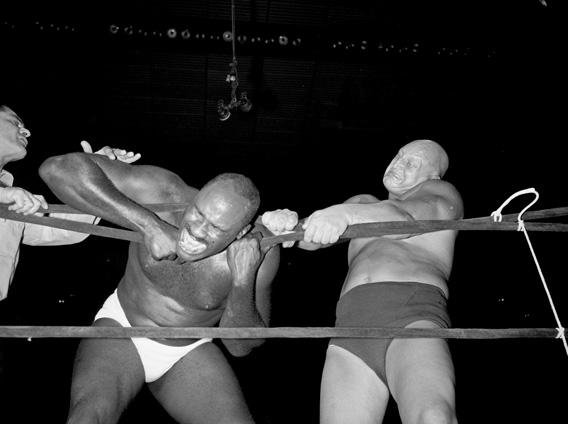 “Villainous Skull” Murphy, early 1950s He became known as “Villainous Skull Murphy,” known for his violence in the ring. He fought the “French Angel,” the “Swedish Angel” and “Gorgeous George.” Village Voice writer Mark Jacobson remembered watching Skull on TV when he was a kid. “Skull was always the bad guy, identified by his special death hold. He’d stomp on a guy’s head when he was unconscious, throw chairs at old ladies who booed him, and rip the microphone from the hands of the announcer. Ed remembered his wrestling career fondly, including Gorgeous George. “The guy was straight, with this fuckin’ peroxided hair and perfume that stunk from here to Canarsie.”
Wrestling money wasn’t enough, so Murphy teamed up with a gay friend to rob dentists, targeting them for shipments of gold from dental laboratories. After 73 dental office robberies, they were caught. Syndicated newspaper columnist Walter Winchell somehow got wind that the culprits were gay. He ran an item in his column that “two swishes with blond hair, whoops, are the notorious Toothache Bandits.” Ed found out who fixed Winchell’s teeth and stole Walter Winchell’s plates. Ed’s favorite Toothache Bandit story concerns a Brooklyn dentist. When Ed and his partner held up the dentist, the man had tears in his eyes. “Don’t take my diamond ring,” he pleaded, “my father gave it to me for my Bar Mitzvah.” Ed let the dentist keep the ring and left with a bag full of gold teeth. Later that night he saw a headline in the Daily Mirror: DENTIST CONS ROBBERS OUT OF RING. He returned to the dentist’s office the next day, beat him up, and took the ring.
In 1947, Ed was sentenced to ten years in state prison. Life was rough in prison. He wasn’t raped. “I knocked down any bastard who tried to touch me. But I spent plenty of time in isolation. The warden didn’t like gay people. Neither did the other inmates. If you bothered with a fag, you were considered pussy yourself.”
When he was released, he worked as a doorman/bouncer in a string of Mafia-owned gay bars including the Cork Club, Bali, Mais Oui, Sans Souci, the 415, the Terrace and Artie’s. “They worked it then that there were three cash registers in the bar,” said Murphy. “Whatever the middle cash register rang up was reported to the government. Some of these spots, like the Pink Elephant, were connected with the Jewish mob. A big owner then was an old politician from Abe Beame’s club. But this was back in the days of Mayor Wagner. Everyone was crooked then…And the cops had their own bag men. You’d pay them $500 a week to keep your joint open.”
At the bars, Ed was “Mother” Murphy to the young male runaways and prostitutes he cared for and sometimes pimped out for tips. Ever the one to moonlight for more money, in the early 1960s Ed Murphy was hired as a house detective at the New York Hilton doing discreet security work. It was in this role that he became an active participant in the infamous “Chickens and Bulls” extortion ring.
Coming Tomorrow: Chapter 3: The Chickens and the Bulls
Chapter 1 – Meeting Ed Murphy
The story of Ed Murphy is fascinating, the way scandal, secrets, and evil are fascinating. It is a story with all the best ingredients—lust, betrayal, corruption, powerful men, redemption, and most of all—irony.
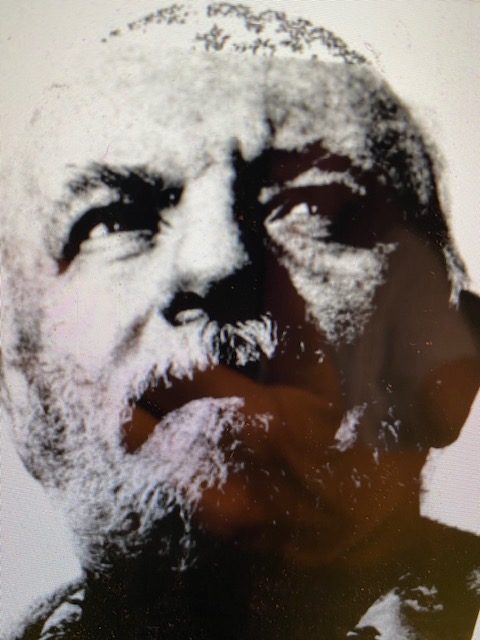 Ed Murphy, 1978 Ed “Skull” Murphy, a gay man who preyed on other gay men, was a secret informer for the FBI. He was protected by the FBI in return for the information he provided on Mafia operations and corruption in New York. He was also rumored to have photos of FBI director J. Edgar Hoover and other prominent government, business and entertainment figures having sex with male prostitutes. Ed Murphy ran prostitution rings of teenage boys and worked as a bouncer in gay bars. He was the doorman at the Stonewall bar the night of the famous raid on June 28, 1969. At that time, he did not identify himself as a gay man. He “came out” a decade later, at the end of the 1970s, when he said that he wanted to quit working for Mafia associates and stop informing for the police and FBI.
Ed reinvented himself as one of the heroes of the Stonewall raid. He continued to work in gay bars. He cultivated a tremendous visibility as the head of the Christopher Street Festival Committee, which organized the vendor booths/party/rally at the end of the annual Gay Pride Parade serving hundreds of thousands of people. Ed Murphy rode in a vintage Cadillac convertible near the head of the parade reserved for those who had been at Stonewall the night of the raid and riots on June 28, 1969. This date is now generally accepted as the beginning of the modern gay and lesbian rights movement.
I met Ed Murphy in the early 1980s when he was working in some bar in the Village, either Stonewall or One Potato, Two Potato. Ed was built like a brick house, stocky and solid, with a body that must have been all muscle in his youth. I was organizing the first group of Conference for Catholic Lesbians (CCL) marchers in New York’s Gay Pride Day parade. We also wanted to have a booth at the Christopher Street Festival in the Village for marchers to hang out after the parade. A booth on Christopher Street would also give us a great opportunity to hand out literature and meet and connect with other lesbians who had been raised Catholic. When I met him, Ed Murphy, or “Mr. Murphy” as I used to call him, was a leader in Heritage of Pride, the organization that ran the parade, festival, and dance in New York City. As such, he was the person to talk to about getting space. Ed always gave CCL table space right in front of St. Veronica’s Church.
“My sister is a nun,” he said to me. “Make sure you take good care of these girls,” he told the guy responsible for assigning spaces.
Our prime location paved the way for many women to find CCL. Ed Murphy always came by our table to make sure that we were fine, and everything was OK. That was my key impression of him: we were small and not influential on the gay scene, but Ed Murphy took care of us. That was also the impression of my friend and CCL co-worker, Barbara M. when she took over organizing the Pride Day booth.
“I remember the last time I had seen him; I was down on Christopher Street and found someone else setting up a booth in our space. I found out that Ed was sitting in a nearby bar, and I went in and found him without any trouble. He seemed to have a lot of adoring fans around him. I told him the story, and he sent out a couple of guys to straighten things out…I thought that they realized Ed was the authority, which prompted them to move, but they may have been afraid of him for all I know…I’d met Ed only three or four times and had short, congenial conversations with him. He was also middle aged by the time I met him. I found him very pleasant. I remember my last conversation with him was his concern that too many of the young fellas were still going bareback, and this was at the height of the AIDS crisis. He said much of the same sort of things I would say today: these kids think they’re immortal; you can’t make them see the seriousness of it because they don’t think it will happen to them. I was never sure if his calling me “Sister” had to do with the fact that I look like a nun or ex-nun…” said Barbara M.
When I met Ed Murphy, I was in my early 30s and he was about the same age as my father. They shared a similar upbringing and formation – the Great Depression and World War II. As boys they were poor, fast with their fists, and nonchalant about thievery. They grew up with no money – they stole to enjoy things their families could never buy. As men they could be gallant or menacing; fiercely protective or brutal. Ed referred to the police by the same name that my father did, “The Bulls.” Big guys with nightsticks that had no hesitancy about using them.
Ed spoke one night to a small group of lesbian and gay Catholics where we met on the Upper West Side in Manhattan. I was very moved to hear the story of his life and description of gay life in New York pre-Stonewall. Ed served time in jail. He stabbed another inmate in self-defense. Ed also made a point to say that he was proud that he didn’t rat people out to “the Bulls.” I had tears in my eyes at the end of his talk. He went through a lot of hell to help bring us to a place where we could live and love more freely. My last memory of him that night was seeing him standing under a streetlight saying goodbye. He looked like an old ex-fighter, scarred, and beaten up, but never a quitter.
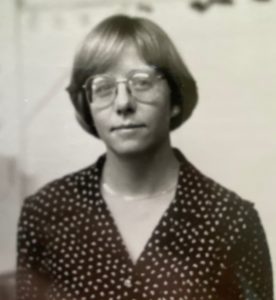 Karen Doherty, 1986 Imagine my shock when, 15 years later, I opened my Wall Street Journal to read an article by William McGowan, “Before Stonewall” which described a vicious extortion ring which targeted prominent and affluent closeted gay men. The gang was finally exposed and put out of business in 1966, but it ran for several years and netted over two million dollars. One of the major figures in this case was Edward “Mother” Murphy, a “ruthless West Side tough” who worked with a dozen other criminals in New York, Chicago, Washington, DC, Los Angeles, San Francisco, and a few other cities to blackmail men who picked up a male prostitute for sex during an out-town trip or when their family was away. “The Chickens and the Bulls,” as the case was known to the New York Police Department and District Attorney’s office, centered on “fairy shaking” or exposing men for their “homosexual proclivities” unless they paid well for it to be kept quiet. Over 1,000 men were victimized by the ring, including the head of the American Medical Association, two Army generals, a Navy admiral, several Hollywood celebrities, college professors and trustees and businessmen.
I relayed my discovery to my friend, Barbara M., who also met Ed Murphy, to hear her reaction. She said,
“To be frank, I’m having a tough time connecting the Ed Murphy I met with the “West Side tough” that he’s described as, or someone who would blackmail fellow gays,” she wrote. “This was in ’65. Ed Murphy was head of security in the Hilton Hotel, and when cornered he cooperated, which is probably why he got the light sentence. Although I think the basic person remains even as the body ages, men mellow. My theory is that the decreased testosterone is a good thing for some of them. Ed may have mellowed a lot and had a metanoia. He struck me as opinioned and forthright, but he didn’t act like a hoodlum. Nonetheless, he might have been. I was just a mere acquaintance; you knew him better. Can you picture that he was involved in this stuff? Maybe prison changed him. His sentence was rather light, and he didn’t serve the entire five years. Maybe he was an informant.”
Many years later, I am still trying to sort out my feelings about Ed Murphy. I knew him as a notable figure in the New York gay community in the 1980s. He was a kind, protective man to the less visible in the city–street kids, drag queens, and mentally challenged children. Ed was generous and caring to all those that he took under his wing, including my group of Catholic lesbians. I am appalled by the image of him as a leader and collaborator in a gay extortion ring, bullying sex and money from vulnerable men and teenagers. Ed Murphy combined prostitution, blackmail and strong-arm tactics into lucrative enterprises that ran for years.
He was also an informer, the worse type of person to anyone of Irish descent. It took the combination of a battery of Irish Catholic New York City Police detectives, the FBI, New York District Attorney Frank S. Hogan, and a federal prosecutor, Andrew J. Maloney, to finally knock him down. But it took the Stonewall raid, a beating by NYC police and a prison rape before he finally had enough and came out as a gay man and activist. That he ended up the Grand Marshall of the New York City Gay Pride Parade 23 years after his conviction for homosexual extortion is a story that boggles the imagination. Catholicism features stories of saints whose lives were full of depravity and evil but ended up redeemed through acts of virtue and heroism. Maybe that is Ed Murphy’s story, or maybe it is just the story he told himself and others.
Chapter 2: “Villainous Skull Murphy” will be posted tomorrow. You can read the whole article Ed_Murphy_Gay_Blackmailer_and_Activitist
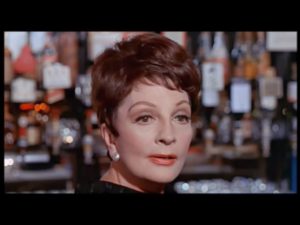 Coral Browne (July 23, 1913-May 29, 1991) was an accomplished stage and screen actress. She was also actor Vincent Price’s third wife. She was a woman who enjoyed a varied and robust sexual life. Browne portrayed no-nonsense BBC-executive, Mercy Croft, in The Killing of Sister George, a film depicting a lesbian love-triangle. She is perfect as a smooth, predatory seductress—a role in which she had plenty of experience. Coral Browne (July 23, 1913-May 29, 1991) was an accomplished stage and screen actress. She was also actor Vincent Price’s third wife. She was a woman who enjoyed a varied and robust sexual life. Browne portrayed no-nonsense BBC-executive, Mercy Croft, in The Killing of Sister George, a film depicting a lesbian love-triangle. She is perfect as a smooth, predatory seductress—a role in which she had plenty of experience.
Coral Browne converted to Catholicism shortly after World War II and remained a devout Catholic throughout her life. As a gift to her, Vincent Price converted to Catholicism. Her friend, Noel Davis, described the melding of her personality and faith: “I’m a Catholic of a sort, and I was always amused by her Catholicism because she was much more devout than fitted in with her obscenities. She never missed Mass on Sunday.” Existing the Brompton Oratory one Sunday morning, salty-tongued Browne was accosted by a theater friend with the latest gossip. She stopped him midsentence, exclaiming: “I don’t want to hear such filth, not with me standing here in a state of fucking grace.”
Browne did not get along with Vincent Price’s daughter, Victoria Price, but they both shared an interest in women. “Coral lent a sympathetic ear to my romantic troubles. Both were eager to meet anyone I brought home, though my stepmother rarely missed an opportunity to flirt outrageously with my girlfriends or to comment on their looks and style. One woman, she told me with a very knowing smile, “does it very well.” I took that as some kind of compliment.” Coral also told Victoria Price about a five-year relationship she had with a woman. Its dissolution was, according to Browne, the most heart-breaking moment of her life. 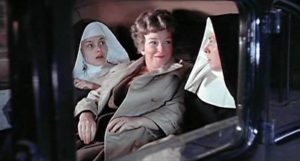
In The Killing of Sister George (1968), BBC executive Mercy Croft (Coral Browne) is sent to chastise Sister George/June Buckridge (Beryl Reid) for a drunken incident involving two nuns. Buckridge is a middle-aged soap opera actress, and Alice “Childie” McNaught (Susannah York), her lover, has a minor fashion industry job, writes poetry and collects dolls. George/June is often verbally and physically abusive to Alice, and her treatment of her becomes worse as her character is scheduled to be eliminated on the popular show. The movie was given an “X” rating because of a two-minute masturbation scene between Coral Browne (Mercy Croft) and Susannah York (Alice “Childie” McNaught). The scene was panned as cold and unsexy—probably because they had most of their clothes on and didn’t writhe and moan continuously. But in 1968 it was revolutionary to see two mature women–McNaught was in her 30s and Croft was in her 50s–having sex to orgasm in a movie.
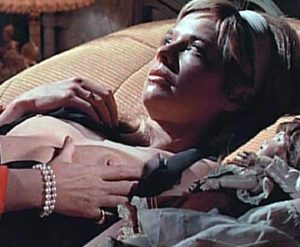
The movie was also history-making in that the director used a real lesbian bar for the lesbian club scene. Between June 9-16, 1968, The Killing of Sister George was shot at the Gateways, a lesbian club that operated in London between 1931 and 1985. Forty members were used as extras, one of whom lost her job when her employer recognized her in a publicity still. George and Alice go to an event at Gateways to which George jokingly invites Mrs. Croft. Mrs. Croft arrives to tell June in person that Sister George will die by being hit by a ten-ton lorry, eliminating her from the show. After June storms out, Mrs. Croft invites Alice to meet with her to further discuss her poetry. Alice has found a new lover/provider and June blew her chance with a woman she once desired and adored.
I wonder how Coral Browne reconciled the sexual and religious aspects of her life. She doesn’t strike me as a hypocrite and didn’t feel obligated to “leave” the Church. Browne died in 1991 without expressing a public opinion or statement; so we’ll never know her thoughts and feelings. The one aspect we do know is that she appeared to value monogamy while married. She had Vincent Price give up a male friend to whom he was strongly attached. That hurt Price deeply. It’s my one mark against Coral Browne.
How do you remain as lesbian and Catholic? My stance—perhaps Coral Browne’s—is to embrace the beautiful and positive in both and dismiss the negativity from secular skeptics and religious gatekeepers. The focus on what is most important – our relationship with God – can be difficult to achieve with all the worldly chatter and distractions; but over time we can sustain it through prayer, quiet time, meditation and the Eucharist.
Click here to see a trailer of The Killing of Sister George.
Click here to see a YouTube video of the Gateways club scene in the film.
 Mosaic at the entrance to St. Michael’s Church In Neil Simon’s 1976 comedy mystery film, Murder by Death, the character Sam Diamond, a parody of the fictional detective, Sam Spade, is played by Peter Falk. His secretary (and girlfriend) blows his cover as a straight, tough guy when she tells the other detectives and guests that Diamond keeps stacks of naked muscle man magazines in his office. Diamond counters that they are part of his detective work –“I’m always looking for suspects!” he says. “I hate them queeries!”
The Rev. George William Rutler, 75, hates queeries, too, but must he have needed new material for an article, Eternal World Television Network (EWTN) program, or one of his pounding homilies. On November 4, 2020, he was caught watching gay porn on the rectory TV by Ashley Gonzalez, 22, a security guard, who filmed a 19-second clip of a man who looks like Father Rutler watching two men blow each other. Gonzalez said she started filming after she heard “sexual noises” on the TV and saw the priest masturbating. Rutler had initially watched election coverage but switched it off around 1:30 am to something more edifying. I think at that point, Joe Biden had beaten Donald Trump for the presidency.
Rev. George William Rutler is one of the most famous conservative priests in the U.S., and a long-time critic of Pope Francis, Democratic politicians and “sodomites.” According to Rod Dreher of the American Conservative, Rutler “presents himself as a flinty arch-conversative who suffers no fools gladly.” He is quite explicit on his view of sex: “The only safe sex is real sex, done for the procreation of life and the sanctification of love.” 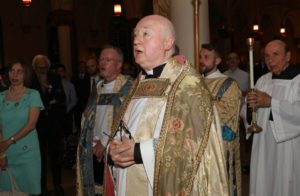
When Gonzalez tried to flee the room, Fr. Rutler grabbed her. “He aggressively threw himself on me and grabbed me sexually, aggressively, and I was fighting him off of me,” Gonzalez told News 12, who added that she sent frantic text messages to her mother begging for help. Gonzalez, who is about five feet tall, got out of the office by elbowing the old geezer in the chest. She made it to the street and called a private detective.
There are a number of weird things in Gonzalez’ story: why would a man who is getting off on two guys having sex try to grope or force himself on a woman? And, how can you possibly have time or your hands free to text your mother if someone is trying to rape or molest you?

What seems unequivocal thanks to a cell phone video clip is that Rev. Rutler’s career as a conservative Catholic spokesman and as a liberal and gay basher is washed up. Even though the assault accusation could be a “he said, she said” situation, the video evidence, and the downloads and browser history on the rectory computer will not lie. Rutler has stepped down as pastor of the Church of Saint Michael Church in Manhattan and has been dropped by EWTN.
One of Fr. Rutler’s quotes on homosexual activity sums up his downfall perfectly: “If people want to engage in aberrant sexual activities, well, by all means then they are free to do so. They are free to pay the penalty.”
P.S. To the Episcopal Church: STOP sending us your self-loathing, hypocritical homosexual priests! We have enough of our own.
“Then Stephen took Angela into her arms and she kissed her full on the lips.” That sentence has thrilled tens of thousands of lesbian readers, including me, to finally see, feel, imagine their desire in print. When British novelist Radclyffe Hall (1880-1943) published The Well of Loneliness in 1928, it was the first widely read novel to feature lesbian love. A British court judged the book obscene because of the words “and that night they were not divided.” 
It tells the story of Stephen Gordon, a woman given a man’s name by parents that wanted a boy, who is irresistibly drawn to other women. She was born on Christmas Eve and named after the first Christian martyr. As a girl she had a dream: “that in some queer way she was Jesus.” Seven-year-old Stephen develops a crush on the Gordon’s maid, Collins. When she discovers that Collins has “housemaid’s knee” she prays that the affliction be transferred to her. “I would like to wash Collins in my blood, Lord Jesus—I would very much like to be a Saviour to Collins—I love her, and I want to be hurt like You were.” Stephen is later devastated when she catches Collins sharing a kiss with the footman.
As a young woman Gordon has an affair when a neighbor’s wife. After a confrontation with her mother about her “unnatural” love, she retreats to her father’s study and discovers a book by German psychiatrist, Krafft-Ebing, on deviant sexuality. After she reads it, she understands what she is—a female “invert,” a lesbian. She opens a Bible, and seeking a sign, reads Genesis 4:15: “And the Lord set a mark upon Cain…” Radclyffe Hall used the mark of Cain, a sign of crime and exile, throughout the book for the status of “inverts.”
Stephen meets Mary Llewellyn, the love of her life, in France during World War I. The two set out to build a life together, but Stephen believes that Mary’s life is suffering because as a couple they are an object of scorn and contempt. To “save” her, she feigns an affair with another woman to drive Mary into the arms of a man who admires and wants her. Mary leaves her and marries. Stephen is devastated and alone. She has a vision of being thronged by millions of inverts from throughout time, living, dead and unborn. They beg her to speak with God for them. Possessing her, she articulates their collective prayer: “God,” she grasped. “We believe, we have told You we believe…We have not denied You, then rise up and defend us. Acknowledge us, oh God, before the whole world. Give us also the right to our existence!”
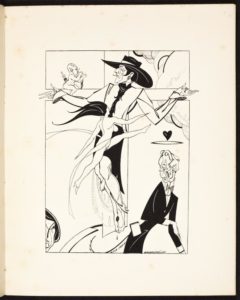
Radclyffe Hall was a pioneer in her efforts to reconcile Christianity and homosexuality. Her defense of gay men and lesbians took the form of a religious argument: if God created inverts, the rest of humanity should accept them. Declaring homosexuality to be a “part of nature, in harmony with it, rather than against it.” She posed the question to her attackers: “if it occurs in and is a part of nature, how can it be unnatural?” She also knew the price that gay and lesbian people pay to remain in the closet and railed against the “conspiracy of silence” saying, “Nothing is so spiritually degrading or so undermining of one’s morale as living a lie.” 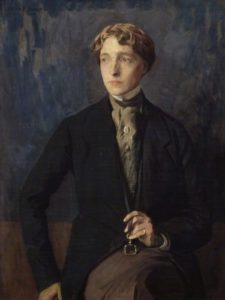
The controversy over The Well of Loneliness was lampooned in The Sink of Solitude, a satirical pamphlet by Beresford Egan, novelist, and illustrator. One drawing shows an immediately recognizable Radclyffe Hall with her trademark Spanish riding hat nailed to a cross. A near-nude Sappho leaps in front of the martyred “St. Stephen” and Cupid perches on the crossbeam. While Egan agreed with Hall’s arguments, he spoofed her piety and moralizing.
Radclyffe Hall is like many Catholic lesbians I have met: conventional, judgmental, spiritual, and often promiscuous.
She was born Marguerite Radclyffe on August 12, 1880 at Christchurch, Bournemouth, England. In later life she was called John by her friends and lovers, and M. Radclyffe Hall or Radclyffe Hall in her books. Her mother, Marie, was an American and her father, Radclyffe Radclyffe Hall, was English. Her parents divorced when she was two and Marie remarried a musician, Albert Visetti. The young girl never liked him. She reached young womanhood without much education or interests except chasing women. Her specialty seems to be the seduction of married women.
In 1907, at 27, unattached and drifting, Hall made a trip to Bad Homburg, Germany, known for its wellness spas and baths. She became smitten with Mabel (Ladye) Batten, a renowned beauty and amateur singer. Batten’s portraits were painted by John Singer Sargent and Edward John Poynter. The 50-year-old married grandmother had ties to aristocratic society and was rumored to have had an affair with King Edward VII. The poet-adventurer Wilfrid Scawen Blunt was an admirer. Witty, elegant, cultured, beautiful and worldly, Batten was everything Hall desired. They became lovers and stayed together until Batten’s death in 1915. 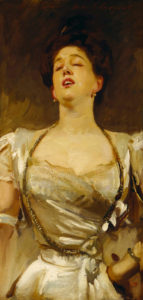
Batten was a major influence on Hall, and encouraged her to write poetry. Hall’s first book of poems, A Sheaf of Verses, published in 1908, reveals her first, tentative references to homosexuality. A second book of poetry including the “Ode to Sapho” was published later that year. Her third volume came out a year later. When Batten’s husband died in 1910, the two women made a home together. Hall’s fourth poetry anthology was dedicated to Batten.
Batten was politically conservative, and Hall adopted her positions. Ladye was also a Catholic convert, and under her encouragement and influence, Radclyffe Hall was received into the Catholic church on February 5, 1912. She was 32. Her baptismal name was Antonia, and she chose Anthony as her patron saint. Hall and Batten worshiped together at London’s fashionable Church of the Immaculate Heart of Mary, known as the Brompton Oratory. In 1913, Hall and Batten made a pilgrimage to the Vatican. They went to Mass at St. Peter’s Basilica. Pope Pius X blessed them in a semi-private audience with other substantial donors. They returned to London with religious-themed triptychs, gilt angels and an alabaster Madonna.
The refined Ladye was both a maternal and wifely figure for Radclyffe Hall. The once-feminine Hall, who wore skirts all her life and only had her waist length blond hair cut in her 30s, started to cultivate a more masculine appearance, close-cropped hair, tailored jackets and bow-ties. Batten gave Hall the nickname “John” after noting her resemblance to one of Hall’s male ancestors. She used this name for the rest of her life. Was Hall butchy, a butch, stone butch, or these days – a transman? It’s hard to say. She said that she had a man’s soul in her body.
In 1915, 35-year-old Radclyffe Hall met Una Troubridge (1887-1963), a 28-year-old cousin of Mabel Batten, at a tea party in London. They were immediately sexually attracted to one another and began an affair. Their relationship that would last until Hall’s death in 1943. Troubridge was a sculptor and mother of a young daughter. She was married to Vice-Admiral Ernest Troubridge, a career naval officer who was 25 years her senior. Hall’s affair with Troubridge caused an uneasy situation among the three women. 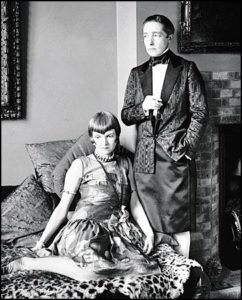
In May 1916, Batten suffered a cerebral hemorrhage after a quarrel with Hall over Troubridge. She died ten days later. Guilty and grief-stricken, Hall believed her infidelity had hastened Batten’s end. She had Batten’s body embalmed and buried her with a silver crucifix blessed by Pope Pius X. Soon after Batten’s death, Hall and Troubridge developed an interest in spiritualism and began attending seances with a medium, Mrs. Gladys Osborne Leonard. They believed Batten’s spirit gave them advice.
Most of the stories, poems and novels Radclyffe Hall wrote touched on Christian themes, Catholic imagery, lesbian desire or all three. In 1924, Radclyffe published The Forge, a fictionalized portrait of American lesbian artist Romaine Brooks, and The Unlit Lamp, a novel about a girl who dreams of going to college and setting up a “Boston marriage” with her tutor, Elizabeth. A Saturday Life (1925) follows the life of a girl who takes up and discards many artistic pursuits with the support of an older woman who is in love with the girl’s mother. Hall’s fourth novel, Adam’s Breed (1926) centered on the spiritual struggles of a young man over excess consumption by modern society. He becomes disgusted with his job as a waiter and even with food itself, gives away his belongings and lives as a hermit in the forest. The story also reflect’s Hall’s concern about the plight of animals. The book won the 1926 James Tait Black Memorial Prize for fiction and the Femina Vie Heureuse Prize for best English novel.
In early July 1926 Hall completed the short story, “Miss Ogilvy Finds Herself,” which dealt with homosexuality. Later than month she began writing Stephen, the novel that became The Well of Loneliness (1928). The Master of the House (1932) is an adaptation of the Christ story in a contemporary setting. Christophe Benedict, the main character, is a deeply spiritual and compassionate carpenter who lives in Provence, France. He is born to a carpenter named Jouse and his wife, Marie. Christophe ends up being crucified by Turks in Palestine during World War I. Writing the book was so spiritually intense that Hall developed stigmata on the palms of her hands.
In the 1930s Hall and Troubridge made their home in Rye, a village in East Sussex where many writers lived. Hall used Rye as the setting for the book, The Sixth Beatitude (1936), her last novel. It is the story of Hannah Bullen, a strong-bodied young woman. Hannah Bullen’s unconventional life (unmarried mother of two children) is beset by poverty and strife within her family. Hall uses the sixth Beatitude to portray Bullen’s purity of heart and mind by sticking with them. An independently wealthy heiress, Hall gave generously to the local church. Saint Anthony of Padua was constructing a new building when they moved to Rye. Biographer Diana Souhami wrote that Hall “poured money into the church” to bring it to completion and furnish it. “She paid for its roof, pews, outstanding debts, paintings of the Stations of the Cross and a rood screen of Christ the King. A tribute to Ladye was engraved on a brass plaque set into the floor: “Of your charity, Pray for the soul of Mabel Veronica Batten, In memory of whom this rood was given.” 
What is the attraction of lesbian and gay men to Catholicism? Why did so many late 19th century writers, intellectuals, artists, clergy and bohemians (with gay lovers, tendencies or friends) take the plunge into the faith? Notable converts include Oscar Wilde, Gerard Manley Hopkins, Aubrey Beardsley, lovers Katherine Bradley and Edith Cooper, Ronald Firbank, Maurice Baring, Eric Gill, Robert Hugh Benson, John Henry Newman, Frederick Rolfe, Marc-Andre Raffalovich, John Gray; and, of course, Mabel Batten, Radclyffe Hall and Una Troubridge.
Oscar Wilde opined on the attraction of the Roman Catholic Church for outre artistic figures and rebels. He said that Catholicism was “for saints and sinners,” while…” for respectable people, the Anglican Church will do.” Becoming Catholic was an act that allowed one to become both rebellious and steeped in tradition. Irish playwright and novelist Emma Donoghue observed: “Being Catholic in England meant becoming slightly foreign, aloof from the establishment; as a church it was associated with the rich and the poor, but definitely not the bourgeoisie.” For much of English society, to become Catholic was to cross society’s lines to a suspect, “other,” even deviant, religion. But the “otherness” may have been a reason behind its attractiveness.
The sensuousness and eroticism present in Catholic art and ritual have a magnetic appeal to lesbian and gay people. Beautiful men, barely covered; women with their heads thrown back in orgasmic passion—a feast for the eyes and imagination. We can appreciate symbolic and hidden meanings, the emphasis on the body, particularly the Eucharist, where we take the body of Christ into our mouth; and the mystery inherent in ourselves and in the spiritual world. 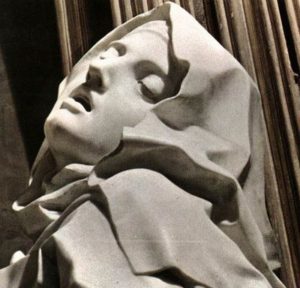
Modern scholars have explored the role of religion in Radclyffe Hall’s work. Catholic Figures, Queer Narratives (2007) includes the chapter “The Well of Loneliness and the Catholic Rhetoric of Sexual Dissidence” by Richard Dellamora. He explores Hall’s life and work. Ed Madden, English professor at the University of South Carolina, examines Hall’s use of Christ’s imagery and symbolism in Reclaiming the Sacred: The Bible in Gay and Lesbian Culture (2003) edited by Raymond-Jean Frontain.
Like a bee sipping nectar from flower to flower, Hall’s desire for women never waned. Her indiscretions as “man of the house” could be overlooked as long as they were brief. Una Troubridge and Radclyffe Hall stayed together as a couple until Hall’s death in London from colon cancer in 1943. The relationship survived Hall’s numerous flirtations and Hall’s last torrid affair with her 28-year-old White Russian nurse, Evguenia Souline (1906?-1958). Souline was hired to help care for Hall during an illness, and their relationship blossomed into much more. Despite the initial protests of Troubridge, the three women lived together in Florence, Italy. At the outbreak of World War II they left and settled in Devon, England. “Darling—I wonder if you realize how much I am counting on your coming to England,” Hall wrote to Souline, “how much it means to me—it means all the world, and indeed my body shall be all, all yours, as yours will be all, all mine, beloved. And we two will lie close in each others arms, close, close, always trying to lie even closer, and I will kiss your mouth and your eyes and your breasts—I will kiss your body all over—And you shall kiss me back again many times as you kissed me when we were in Paris. And nothing will matter but just we two, we two longing loves at last come together. I wake up in the night & think of these things & then I can’t sleep for my longing, Soulina.” Una Troubridge cannot have been happy reading that note. Even so, much of Hall’s correspondence to Evgenia Souline has been preserved. Troubridge burned Souline’s letters to Hall.
Radclyffe Hall died at her flat in Pimlico on October 7, 1943. She bequeathed her entire estate to Troubridge. At her request, she was buried in a vault next to Mabel Batten in Highgate Cemetery in London. Souline was given a small allowance and disappears from the story. At the time of her death, The Well of Loneliness had been translated into 14 languages and was selling more than 100,000 copies a year. It has never gone out of print. For decades, it was the only lesbian book generally available. 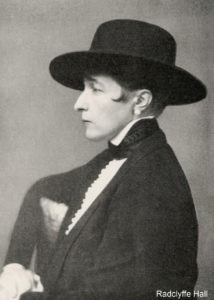
Troubridge, now a wealthy woman, moved to Italy and died of cancer in Rome in September 1963, at age 76. Shortly before Troubridge died, a woman asked her how she and Hall reconciled their relationship with their Catholic faith. What did they do about confession? Troubridge answered, “There was nothing to confess.” Troubridge left written instructions that her coffin be placed in the vault in Highgate Cemetery where Hall and Batten had been buried, but the instructions were discovered too late. She was buried in the English Cemetery in Rome, and on her coffin was inscribed, “Una Vincenzo Troubridge, the friend of Radclyffe Hall.” Years later her tomb was removed and her remains were lost.
The Well of Loneliness has been criticized by lesbians for its stereotypical butch-femme coupling, energetic lesbians who are always masculine looking, and requisite unhappy ending of a love affair or relationship between two women. What is totally ignored is Hall’s Christianity and Catholic faith in her life and writing. A friend once observed to me that it is easier to be a lesbian in the Catholic Church than a Catholic in the lesbian community. Like 19th and 20th century biographers who often left out, or slyly alluded to their subject’s homosexual life; too many “herstory” archivists, writers and editors deliberately omit lesbian religious faith and commitment. This bigotry needs to stop.
“Who are you to deny our right to love” – Radclyffe Hall The Well of Loneliness
|
































